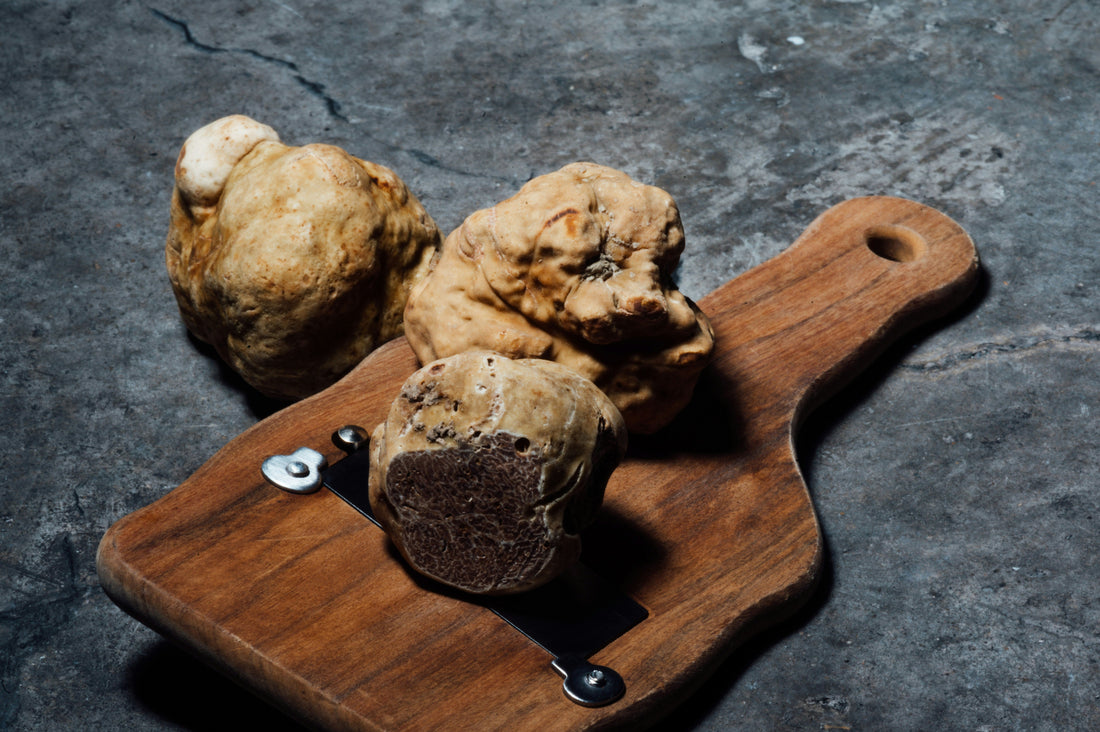
Truffles from Italy: Types, Season, Quality and Preparation Tips
Italian Truffles: Types, Season, Quality & How to Use Them in the Kitchen
What are truffles and why are they so expensive?
Truffles are rare underground fungi that grow in symbiosis with the roots of trees like oak, hazel, and poplar. They’re prized for their deep, earthy aroma and complex flavor—and for their scarcity. Found only in select regions and harvested by trained dogs, truffles are considered one of the most luxurious ingredients in the world.
Italy is one of the top producers of gourmet truffles, especially in regions like Piedmont, Tuscany, and Umbria. Among them, the white truffle from Alba (Tuber magnatum pico) is the most coveted, often selling for thousands of euros per kilo due to its intense aroma and short harvest window.
The combination of seasonal rarity, natural growth, and labor-intensive hunting makes truffles a culinary treasure worth savoring.
What types of truffles grow in Italy and how do they differ?
There are several types of truffles found in Italy, each with its own season, aroma, and culinary application. Here are the most important ones:
White Truffle (Tuber magnatum): The rarest and most expensive. Found mainly in Piedmont and harvested from October to December. It has a pale beige skin and a pungent, garlicky aroma. Best enjoyed raw and thinly shaved.
Black Winter Truffle (Tuber melanosporum): Harvested between December and March in central Italy. Dark, warty skin with a chocolatey, nutty aroma. Great for sauces and warm dishes.
Summer Truffle (Tuber aestivum): Available from May to August. Milder in aroma with hints of hazelnut. More affordable and commonly used in casual truffle products.
Burgundy Truffle (Tuber uncinatum): A fall variation of the summer truffle with a deeper aroma. In season from September to January.
Bianchetto Truffle (Tuber borchii): Found in early spring, it resembles the white truffle but has a stronger, more garlicky profile.
When is truffle season in Italy and where can you find them?
Truffle season depends on the type. Italy offers fresh truffles nearly year-round, but peak seasons vary:
White truffle: October to December. Best found in Piedmont, especially Alba.
Black winter truffle: December to March. Common in Umbria and Tuscany.
Summer truffle: May to August. Found in regions like Marche, Abruzzo, and Apulia.
Burgundy truffle: September to January. Grows in central and northern Italy.
Truffles are typically foraged in wooded areas with calcareous soil, often with the help of specially trained dogs. Visiting Italy during harvest season offers a unique culinary experience, including local truffle fairs and tasting menus.
How can you tell if a truffle is fresh and high quality?
Smell is the most important factor: A fresh truffle should have an intense, pleasant aroma. White truffles smell garlicky and musky; black truffles smell earthy and nutty. If the scent is faint or musty, the truffle is likely past its prime.
Touch is also key: A good truffle feels firm and slightly springy. It should never be soft, slimy, or dried out. The skin should be intact, whether smooth (white) or bumpy (black).
Size and shape affect the price but not the taste. Uniform, round truffles fetch higher prices, but smaller ones are just as flavorful.
When in doubt, buy from trusted sources that provide harvest details and origin certificates. The best truffles are always local, fresh, and traceable.
How should you store fresh truffles and how long do they last?
Fresh truffles are delicate and start losing aroma soon after harvest. Store them in a glass jar or sealed container, wrapped in a paper towel to absorb moisture. Keep them in the refrigerator at 2–4°C (36–39°F).
Change the paper towel daily. White truffles last about 3–5 days, while black truffles can stay fresh up to 10 days with proper care.
Some people store truffles in rice, but that method dries them out and is only suitable short-term. Freezing or preserving in oil is possible but will reduce the aroma significantly.
Can you cook with truffles or should they only be used raw?
Yes, but it depends on the variety. White truffles should never be cooked. Their delicate aroma disappears with heat, so they’re best shaved raw over warm dishes.
Black truffles are more robust and can be gently heated. They’re great in sauces, infused butters, or folded into pasta fillings. Cooking can even enhance their flavor if done gently.
Truffles work best with simple, fatty ingredients like butter, cream, or eggs. Avoid strong spices or acidic elements that overpower the truffle’s flavor.
What dishes go best with truffles?
Truffles pair beautifully with simple recipes that let their flavor shine. Top choices include:
- Tagliolini or fettuccine with truffle butter
- Risotto with Parmigiano and black truffle
- Scrambled or fried eggs with shaved white truffle
- Mashed potatoes or polenta with truffle oil
- Carpaccio or veal with truffle shavings
In modern cuisine, you’ll also find truffles paired with seafood, cheeses, and even desserts like truffle honey over vanilla ice cream.
Why is investing in real truffle worth it?
Real truffles offer a depth of flavor no artificial aroma can match. They elevate even the simplest dishes into gourmet experiences with just a few shavings.
They’re also naturally healthy: Truffles are low in calories, rich in minerals, and contain antioxidants.
Choosing high-quality truffles supports small producers and helps preserve sustainable foraging traditions in Italy. It’s not just luxury—it’s cultural appreciation and pure culinary joy.
